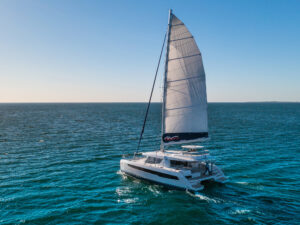
The Bare Bones About Bareboats
At Swaying Palms Sailing Vacations, the phone’s ringing off the hook, and the e-mail inbox is full. Questions, questions, questions.
“Can we sail naked?” “Do sails come with the boat?” “Can I bring my hair dryer?” “Will my cellphone work?” “Can I use my iPod?” “Can we rent a big-screen TV?” “I’m a powerboater, and I don’t know how to sail. If I promise not to raise the sails, can I still charter the boat?” “What’s the difference between a monohull and a catamaran?”
“Does ‘bareboat’ mean there’s nothing on the boat?”
“I see there’s a charge for sleeping aboard. Does that mean I have to get off the boat every night?”
“The water’s so blue! Can we bottle it?”
“Are the islands there in the summertime? How do you keep them from moving during hurricanes?”
“Are there pirates?”
“Why is it so hot?”
Wacky? Ludicrous? Maybe so, to experienced charterers and cruisers, but at Swaying Palms-and at all of the actual companies in the business (see “Charter Address Book,” (coming soon)-these questions-all of them real ones posed to charter companies by flesh-and-blood charterers-are expected and encouraged. The notion of sailing an unfamiliar boat outside of home waters should provoke lots of questions.
To foster curiosity and to satisfy it, companies and brokers work hard to demystify the chartering experience and educate potential clients. One company publishes a timeline that helps charterers check off the list of items they need to accomplish before arrival at the base; one broker has created a chat room and a monthly e-mailed newsletter specifically about chartering; another company produced a DVD with real bareboat sailors as the actors. Some companies offer sailing schools and flotillas. A few have helped charterers make reservations for marina slips, dinner, and, yes, weddings. And one company allows wary bareboaters to borrow a skipper for the first afternoon at no charge to guarantee they’ll succeed the first time they cast off the dock lines.
Not all queries are as unconventional as those at the beginning of this story: What qualifications are needed to bareboat? How much will the trip cost? What’s the best time of year to cruise in my destination of choice? What anchorages and islands should we explore? How do I provision? Are towels, bedding, and water toys provided? Will there be help in case of an emergency?
Through them all, companies abide by a golden rule, one that may account, now and then, for some far-ranging queries but is intended to promote successful sailing vacations. “Never hesitate to ask questions-no matter how trivial,” says Sofia Fay, marketing manager at Horizon Yacht Charters. “Assumptions sometimes can lead to problems upon arrival at the base.”
The Three Rs
Grab a pair of dime-store magnifying eyeglasses and an atlas. Those are the tools you really need to follow what brokers and companies consider the single most essential piece of advice-one that clients usually fail to follow.
“Ninety-nine out of 100 problems can be solved by reading,” says Gordon Reed, broker for Ed Hamilton & Co.
Others in the business agree: “People don’t read the information we send them,” says Fay of Horizon. “And when they arrive, they’re in a bit of a pickle.”
Don’t just scan the websites. Read them thoroughly, and read the contract down to the fine print. “Do your research-on the cruising area, the weather, the boat-and read and digest the information that we send you in advance,” says Narendra “Seth” Sethia of Barefoot Yacht Charters in St. Vincent.
And would-be navigators: Figure out where the British Virgin Islands are; realize that Road Town (on Tortola and the capital of the British Virgin Islands) and St. Thomas (an island in the U.S. Virgin Islands) aren’t the same place and that sailing from New York to the Caribbean is a rigorous offshore delivery, not a leisurely wander among palm-fringed anchorages. After studying your atlas, you won’t be caught asking, as someone did of Barefoot’s Seth: “If we want to sail from Miami to the Grenadines and back, is it possible to do it in four or five days, or do we have to take a whole week?”
Sailing Competency
While you don’t have to be a Coast Guard-licensed captain to qualify to bareboat, companies look at levels of sailing and boathandling experience. If you have little or no sailing experience, consider hiring a skipper for the whole trip. Or you could turn your vacation into a learning adventure by enrolling in a sailing school run by a charter company. Still haven’t found what you’re looking for? If you’re not a rank neophyte, you can hire a skipper for as little as an afternoon, a day, or part of the trip; another option is to join a flotilla, which allows you to sail your own charter boat while drawing on the resources of a charter company-led fleet.
If you own or have owned a boat, if you’ve chartered before, or if you’ve achieved certification from a reputable school offering either American Sailing Association or U.S. Sailing courses, companies and brokers want to know, so include that in your sailing resume. “Charterers need hands-on cruising experience on a comparable vessel in a comparable cruising area,” says Barb Hansen, owner of Southwest Florida Yachts. “For example, daysailing on a lake in Georgia may not prepare you adequately to handle a larger vessel in Florida and deal with charts, tides, and currents.”
Realize that requirements are as specific as the companies themselves, so shop around. “Each company has different procedures for qualifying their charter guests,” notes Rick Sale, general manager of San Juan Sailing.
While some clients prefer small companies, for others, larger is better. “The advantages include new boats, greater service, great maintenance, worldwide destinations, the level of insurance, and loyalty programs for
repeat customers,” says brand manager Josephine Williams of First Choice Marine, corporate owner of, among other fleets, The Moorings and Footloose, its budget division.
Remember, too, that the more you charter, the more your skills are bound to improve. “Once first-time charterers go, they’re hooked,” says Susan Lengyel, vacation consultant for Sunsail Sailing Vacations. “If they go with a skipper the first time, the second time they want American Sail Association courses.”
Hansen, whose company offers introductory through advanced curricula, says, “I tell people that the course is your ticket to start learning. No course can teach you everything; however, from that point, you can begin your sailing adventure, and each time you cruise, you’re adding to your experience resume.”
Packing
F. Scott Farquharson of Annapolis Bay Charters offers easy-to-follow steps on the item all companies declare is the second most important piece of advice for vacationing sailors: “Pack your bags,” he says. “Put them on the floor and look at them. Then unpack half of what you packed. Look at them again. Unpack half. Repeat, and you still will have too much. And no wheelie suitcases!”
Adds John Jacob of CYOA Yacht Charters: “Pack a carry-on with medications, personal items, a change of clothes, and a bathing suit. Be prepared for the airline to delay or even lose your baggage. Don’t pack anything valuable. You can purchase T-shirts, shorts, and bathing suits along the way.”
The point is that sailing is no formal affair. “Bring half as many clothes as you think you’ll need,” says Cindy Chestnut of Conch Charters, “and twice as much money. You’ll have a wonderful time.”
Advice from the Experts for First-Time Charterers
San Juan Sailing
“Don’t bite off more than you can chew. Start small with a boat size that you are very comfortable with and work your way up from there (increasing boat length up 6 feet with each charter is considered reasonable). This will ensure that you spend your vacation enjoying yourself and your time out in the islands without extra stress and a big knot in your stomach. Keep the knots on your knotmeter!”
Danelle Kornelis and Rick Sale
Barefoot Yacht Charters
“Don’t rush to get off the dock. Be 110 percent sure you’ve been fully briefed on everything, that you have everything that should be on board, and that you are satisfied with the operation of all on-board systems (Most of the problems we experience on bareboat charters are the result of customers falling asleep during the briefings or not listening or not properly checking their inventory.) Don’t overload the yacht with too many people. This may save money on an individual basis but it invariably leads to problems.”
“Seth” Narendra Sethia
Ed Hamilton & Co.
“In the charter industry you really do get what you pay for. The less expensive boats are older. If you don’t want to pay for a new boat that’s fine, but don’t complain. Thoroughly look at the boat before leaving the base. Address issues and problems in a timely fashion. If something goes wrong call the charter company during the charter, don’t call the broker three months later. These are boats. They’re not perfect.”
Gordon Reed
Sunsail
“It’s important to look at several companies to see how we all compare. It’s important for clients to shop around and see other service guarantees to see what sets us apart. Ask your self what you want: Seclusion? Nightlife? Fishing?”
Susan Lengyel
The Moorings
“At the Moorings, if you’re a first-timer and still unsure of your skills, we’ll give you a skipper free for half a day. Also, flotillas lend much support in that there’s a lead boat, technical support, a hostess. They’re great for a first-timer.”
Josephine Williams, brand manager, First Choice Marine
Horizon Yacht Charters
“‘Where are you?’ I’ve been asked. Talking to people who can actually see the boats tickles charterers. It gives them a bit more comfort to know we’re actually in the destination.”
Sofia Fay
CYOA Yacht Charters
“You are a visitor to a different community and culture. This is not your backyard. Listen, observe, be respectful. Treat islanders as you would expect to be treated by visitors to your hometown. Be flexible; assume there will be delays, mishaps, changes of plan, and other twists and turns along the way. Make the most of it. This is not the Pirates of the Caribbean ride at Disneyworld. This is a hands-on, participatory experience. You must be involved.”
John Jacob








